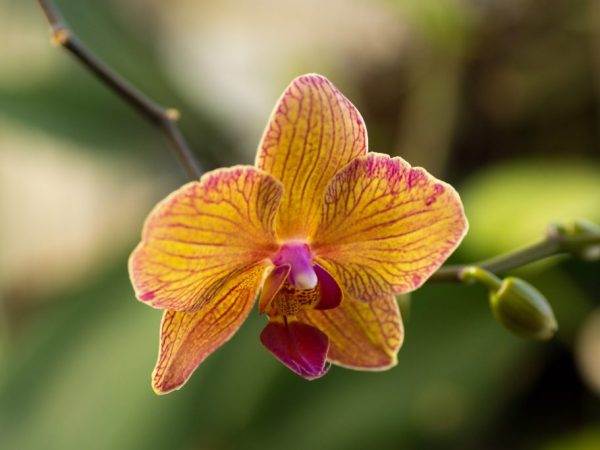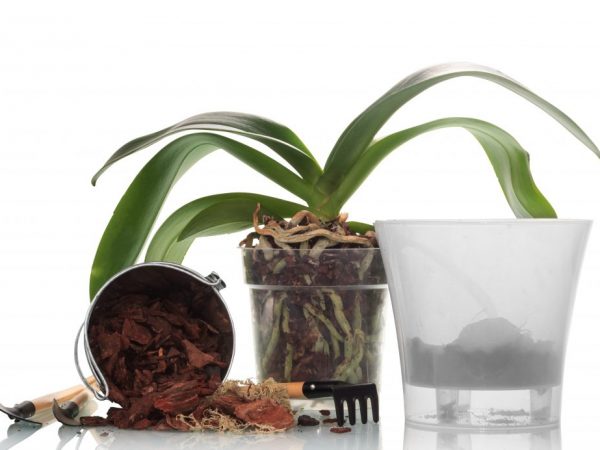Growing Phalaenopsis Parrot
Phalaenopsis Parrot is considered an ambiguous plant. It has so many names that it is easy to get confused in them. This does not prevent him from being popular and decorating houses.

Phalaenopsis Parrot
Plant characteristics
The height of a mature plant is 60 cm. Before flowering, 3-4 pairs of green leaves are formed on the bushes. Their length is 20 cm, width is 10 cm. The end of the leaf is characterized by the presence of a small pointed nose of an asymmetric shape. The surface of the sheet is smooth, glossy.
Flowers are formed by families. Usually the flower consists of 20 inflorescences up to 1 cm in diameter. Their color varies from yellow to burgundy. It all depends on the fertilizer that the gardener uses. The root system is well developed.
Growing features
The Parrot Orchid will produce beautiful flowers when planted in the correct substrate. It is usually bought at agricultural stores or prepared at home. To do this, take 1 kg of soil from the garden and add 2 kg of pine bark to it. Orchids fully develop only in the coniferous bark.
Landing
Planting in transparent pots is important to ensure that the root system receives the required amount of sunlight. In such containers, a drainage system and ventilation are installed, which will prevent the accumulation of water in the roots. It is better to use plastic containers in which it is easier to create a drainage and ventilation system with a kitchen knife.
Transfer
The Parrot orchid is transplanted only after its root system is formed. The transplant is carried out with an interval of 3-4 years, at which time the substrate is replaced, which has lost useful substances. The first landing is carried out according to the following scheme:
- the roots of the seedling are placed in a container and evenly distributed;
- the space between the filaments of the roots is filled with the substrate;
- the soil is well compacted;
- the plant is placed in a dark, cool place for 1-1.5 weeks;
- water the Parrot orchid at intervals of 2 weeks.

Phalaenopsis Transplant Parrot
Care rules
The plant is provided with the optimum temperature and humidity. Daytime temperature 24-26 ° С, at night 16-18 ° С. The optimum humidity is 70-80%.
An orchid needs quality lighting. Care should be taken not to direct the sun's rays, as there is a risk of sunburn on the leaves.
The culture is watered every 3-4 days, depending on climatic conditions. The pot is placed in a container filled with warm water, literally for 10-15 minutes, after which the pot is allowed to dry. Water is not poured into the soil itself. Fertilizers are applied as needed. If the orchid does not bloom well, add a superphosphate solution (20 g per 10 l of water). If the color of the sheet is defective, a solution of potassium nitrate (30 g per 10 l of water) is added. If there are problems with the root system, add ammonium nitrate at the rate of 10 g per 10 liters of water.
Pruning of dry inflorescences is carried out when the color stick is completely dry: the culture will re-discard the buds and bloom.
Diseases and pests
The main diseases are urticaria and botrytis.To combat urticaria, the humidity and air temperature in the room are normalized. A means of combating botrytis is treatment with a solution of Bordeaux liquid (2 g per 5 l of water).
Thrips and scale insects are isolated from pests.
- Thrips are fought with the preparations "Hostakvik" or "Isatrin" (20 g per 10 liters of water).
- A measure of the fight against the scabbard is to treat the leaves with a soap solution (rub 1 bar of laundry soap and add 5 liters of water to it).
Preventive actions
Diseases affect the plant primarily due to improper care. Preventive measures include:
- normalization of watering, feeding and pruning;
- soil treatment with disinfectants before planting; for this, a manganese solution (2 g per 10 l of water) or colloidal salt (3 g per 10 l of water) is used;
- inspection of the seedling before planting; all damaged or diseased areas are removed.
Conclusion
Orchid care The parrot should be as effective as possible, the appearance of the plant depends on it. If you adhere to the recommendations for planting technology and care rules, it will not be difficult to grow a full-fledged and developed plant.


